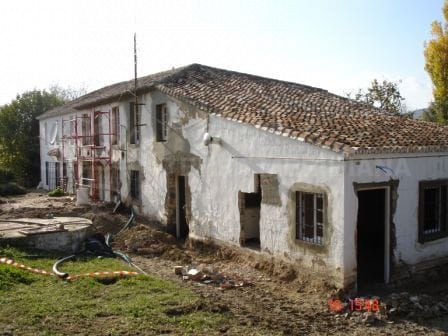Property News
The story of a restoration in the Andalusian countryside
John and Jane shared a passion for horse-riding and Southern Spain. Having undertaken several refurbishment projects in the UK and one in Southern France, the British couple wanted to create a property that was maintained in shape all year round. With this in mind, they set out on an exploratory drive through Spain and instantly knew they had found what they were looking for when they discovered an existing Spanish finca set in seven acres of land near Ronda. There was considerable work to be done both structurally and in terms of landscaping but the potential could clearly be seen.
The couple wanted to use the house occasionally for themselves and their children but also to rent it out to holidaymakers seeking a spacious beautiful home in the countryside that offered a host of possibilities however long they would stay. They also wanted to be near enough a population centre so that it wouldn’t be necessary to go on a boringly long drive to access basic amenities, or difficult to call upon a caretaker, gardener, or any other help for the house.
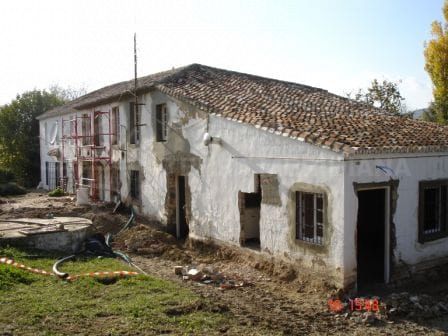
They decided to entrust a local resident and friend to maintain the property in perfect shape year-round. They also found another trustworthy local ally to manage the construction. “We inherited the builder of the lady who had sold the house to us: a lovely Andalusian with a winning smile, for whom nothing was too much trouble. In fact, it was easier to manage this job in Ronda from the UK than many other building jobs in the UK,” John explains.
The fact that this local personal attention existed even in the owners’ absence resulted in an unusually fast and smooth restoration project. As an example of the work that went on, mouldings photographed in Mallorca were e-mailed to the builder so that they could be replicated. And it was John and Jane themselves with the help of a very talented carpenter friend who designed many of the house’s new features, while an architect was called upon only for compliance matters.
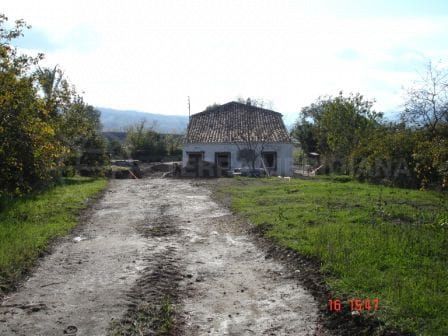
Dating back about 100 years, the original house was a simple two-floor structure, but the restoration transformed it into a veritable mansion offering endless possibilities. A wide colonnade was added along one side, perfect for outdoor dining, while a large courtyard was built along the other side, with huge gates with a Moroccan feel leading from there to the gardens beyond. Over and above providing much needed shade, these structures look, by design, as if they have always been part of the house.
New windows and beams were installed throughout, also looking as if they had always been there. Modern elements were put in such as under-floor heating. We wanted “all bells and whistles for the restoration” says John. The largest room downstairs is the living and dining space, occupying the entire width of the house and boasting windows in three directions. Adjacent to the dining area is the large kitchen, whose generous work surface overlooks the garden. The guest bedrooms, each with a different view of the surrounding countryside, and ensuite bathrooms, occupy the whole of the first floor, and there is also a lovely apartment, with its own garden, complete with a separate living room and kitchen.
In terms of decor, space, the predominance of white, and a subtle decorative style that is neither particularly modern nor classic are the distinguishing factors. This is a stately country style that is not excessively formal, resulting in a sophisticated yet soothingly simple living atmosphere. To enhance the abundance of light and space, the exposed wooden beams were also painted white. Moderately darker textiles, the earth tones of the large floor tiles, wooden furniture with soft lines, books on the many built-in shelves, and the occasional soft yellow or blue all provide a just measure of contrast to this general clarity. The emphasis is not on particularly ornate corners or flashy centrepieces. The form and extent of the natural space have been respected, and features are simultaneously handsome and functional. For example, in the pool gardens, there is a walk-in shower whose circular structures, lattice woodwork, and pastel blues recall the traditional hammam and the form of a sea shell. In all, the existing decor is stylish, appropriate, and subtle enough to make it easy to imagine a new owner deciding to keep it just as it is, at least for some time, before bringing in his or her personal touch.
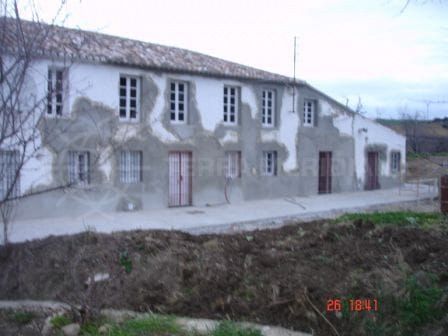
Of course a key asset of the property is the seven acres of land on which it stands. There was once a market garden here, and the creation of such a welcoming outdoor space must have been made possible by the combination of Andalusia’s exceptional weather and English gardening savoir-faire. A large enclosed pool garden was created about 50 yards from the house. “Being some distance from the coast, we wanted to create a space where people could spend all day without an urgent need to drive to the beach,” says Jane. The outdoor dining rooms also includes a bar, under a thatched roof much like that of a Maldivian hut. Extensive planting around the lawned garden surrounding the pool adds to the general ambience of this delightful area.
Outside the courtyard and around the house, a complete irrigation system was installed. Large expanses of lawn were laid, and new shrubs, flowerbeds and fruit trees were added. The result is simply stunning: although major planting and earthworks took place it took just two years for the garden to green up. For shady spaces, pergolas have been used rather than less attractive and more commonplace umbrellas. And quite naturally, given the owners’ practice of horse-riding, there is a paddock and stable
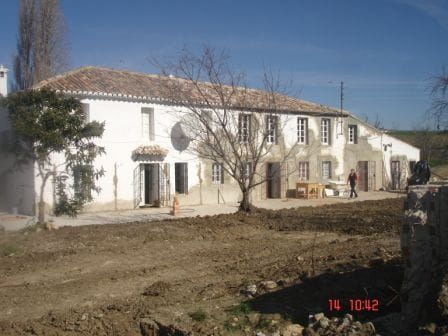
But what of the countryside surrounding the property? As it overlooks a gorgeous valley of the Grazalema National Park, the finca is indeed the perfect place to keep horses and from which to go on memorable rides, or equally relaxing and varied walking excursions. The deepest section of the Guadiaro River valley, which gently slopes down from Ronda to Sotogrande, is called Valle del Libar. Far from any major road and famous for its beauty, this is the route of the railroad track from Algeciras to Madrid. Valle del Libar is famed for its natural and cultural riches: breathtakingly deep gorges, quaint villages with gastronomic specialities, an enormous cave system well-known to spelunkers nationwide, and the exotic fauna and flora of southern Andalusia– cork oaks, bougainvillea, mongoose, chameleons…
As was said previously, the Smiths wanted a rural spot but not one completely off the beaten track. The location is not so isolated that town-oriented attractions are to be written off. By car, you are only five minutes away from the beloved town of Ronda, where Romans, Moors, and Christians successively left intriguing signs of their civilisations. At the turn of the eighteenth and nineteenth centuries, Goya frequently showcased the essence of Ronda life, depicting the dramatic old quarter, perched high up over both sides of the Guadalevín River and Tajo gorge, or glamorous fights in the bullring, as the town, unbeknownst to many, is the birthplace of this tradition.
The finca is also about one hour’s drive from either Malaga or the Costa del Sol. Malaga is Spain’s third city and as such features an international airport, an important university, and many cultural attractions including the recently inaugurated Picasso Museum and the Cervantes Theatre, where world-class events are held all year. As for the Costa del Sol, this stretch of coast includes the resorts of Marbella, Puerto Banús, and Sotogrande, as well as other noteworthy towns. The area is considered the best destination for golf and seaside luxury living in Spain, but the lesser-known hilly interior is full of secret and not-so-secret treasures. Seville, Jerez and Granada are easily visited in a day trip to each.
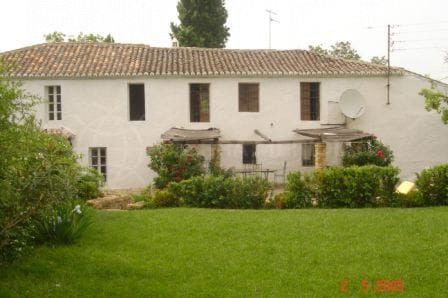
So it is no surprise that the finca has seen such success as a rental house, being let for no less than half the year in 2009. Testimony to this is the eloquent praise left on the wonderful Web site that John and Jane created for the house, whose design and user-friendliness echo the attention to detail so characteristic of the property itself. One of these many delighted guests offered this rather impressionistic tidbit: “The lavender sweep: the splash of the pool: the sun makes you smile, the shade keeps you cool; the kindness of hosts, the light through the grass; the food on the table, the wine in the glass; the coolth of the house, the warmth of the staff; the pop of a cork, the hoot of a laugh; the quiet of friendships, some old and some new; the noise of a party, the swallows, the view; the gold checkered valley, the blue distant mountains; the ant on the cobble, the burbling fountains; the pointing of poplars, the fragments of art; this magical finca has entered my heart.” Anyone stumbling on the Web site is sure to note the beauty of the photography in particular, which displays the home in all its glory.
What we have here then is a rural property in the heart of Andalusia bringing together local flavour and English country living traditions. In addition to the style of the home itself, a clear advantage is a location that offers the best of three worlds: the quiet and beauty of the countryside, a historic small town nearby with all its facilities, and larger sea resorts and urban centres quickly accessible by car. All of which combine to form an enticing opportunity indeed for the discerning investor searching for a country home in the sun.
By Eloise Horsfield | Property News | March 4th, 2010
